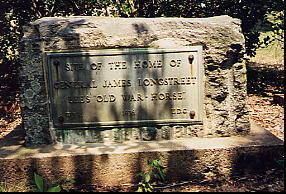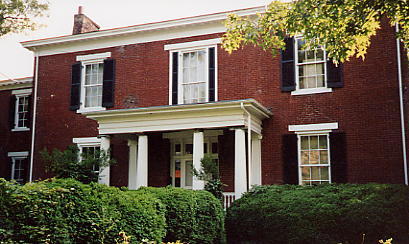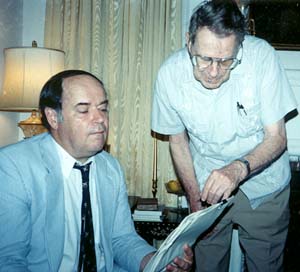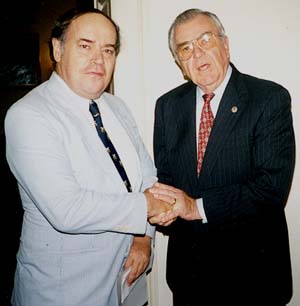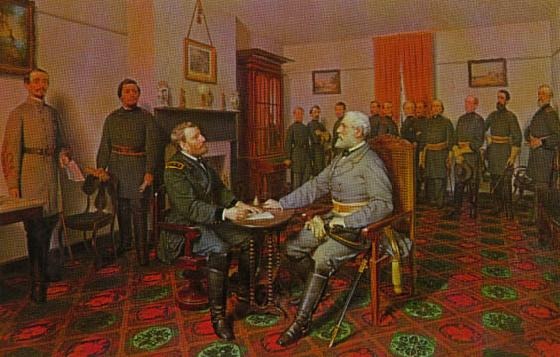GENERAL LONGSTREET RECOGNITION PROJECT
Association Action to Memorialize sponsored by All Rights Reserved Background Despite a distinguished military record and several brilliant victories where his prescience, strategic vision and well-executed tactics saved the Army of Northern Virginia from certain destruction, General Longstreet was unfairly scapegoated and blamed for the loss of Gettysburg (and the war itself) for many years after the conflict. Within the past decade historians and Civil War experts have refocused their attention on Longstreet with a view toward rehabilitating his reputation with a more balanced assessment. Widespread public interest around by Ken Burn's PBS series on the Civil War in 1990, followed by the movie, Gettysburg (1993), augmented the interest in Longstreet. Various programs, roundtable groups and memorial funds emerged as a consequence of the Longstreet "revival," culminating with the unveiling of a Longstreet statue on Seminary Ridge at Gettysburg in July 1998. [Note: See "The Search for Longstreet's Honor: The Power of Nostalgia" for more information on past tribute campaigns.] Despite these good efforts there remains a strong sentiment among Longstreet's modern-day admirers that more can and should be done to rectify the wrongs heaped upon "Old Pete" and his family for the sake of honesty and decency in the treatment of heroic (if controversial) figures and American History itself. At a time when the nation's values, its character and leadership development qualities seem at risk, especially with the younger generations, the challenge to reinvigorate American history is daunting. Yet, serious students of our political process recognize that historical lessons and a revival of "old-fashioned civic values" will be critical if the nation is to realize its potential for greatness and contain the spread of the "poison" politics of personal destruction, greed and corruption. Just as these negative, media-driven barrages took a toll on Longstreet and his family and countless other Americans, we are all reduced by these vicious, orchestrated falsehoods. Our history becomes distorted and truth becomes a casualty. Moreover, we as a nation are nullifying, even negating the enormous sacrifices made by our ancestors, particularly the noble soldiers like Longstreet, if we permit the erasure from history of their lives and achievements --the actions which have created our current bounty. James Longstreet's life encompassed much of the tumultuous nineteenth century. As a West Point-trained officer, Longstreet served with distinction in the Mexican War and matured with the young nation's Manifest Destiny, honing his military skills in the rough wilds of the West. Longstreet knew the frontier and its values, and he drew strength and vision from his experience which served him well in the Civil War and beyond. Longstreet's struggles with the exigencies of the South's military situation and his acute awareness of broad facets of the interlocking tragedy which unfolded after Appomattox did not inoculate him from one of American history's cruelest outbreaks of scapegoating and ostracism through which he endured an unrelenting barrage of personal attacks on his military record and beliefs. For nearly four decades Longstreet stood against the ill winds, did his duty, and helped the country grow into an industrial power.
Serious students of American history need to understand Longstreet's life, especially after his last great battle at The Wilderness (where he was nearly killed by accidental wounding) -- what happened to him and why it happened to gain a fuller understanding of what has transpired in the past one hundred and fifty years. There are profound lessons for all of us in understanding Longstreet, his trials and times, especially during the sesquicentennial years (2011-2015).
Objectives
GLRP seeks to do the following:
GLRP is achieving these objectives by blending its activities with public relations and legislative/education programs on the national level in cooperation with others who share GLRP objectives (e.g., Longstreet Memorial Fund, Longstreet Memorial Association, various preservation groups and Civil War Roundtables). GLRP is chronicling Longstreet's military achievements through key battles such as the Wilderness, Chickamauga, Second Manassas and Antietam where the General's participation was decisive. The aim of this prong is the erection of a monument and/or other physical markers to provide more lasting recognition of the General's presence in important engagements. Another prong will illuminate Longstreet's post-war life, especially during Reconstruction.
Current Situation Expectations Method of Operation Supporters The Agribusiness Council (ABC) continues to demonstrate interest in researching prominent leaders who have contributed to America's rural development and/or who exemplified moral courage in pursuit of the national interest. ABC's late chairman, U.S. Senator Jennings Randolph of West Virginia (1902-1998), was an admirer of General Longstreet and a distant relative through the Fitz-Randolph family. Randolph shared Longstreet's keen interest in military technology, but was most remembered for his pioneering efforts in international peacekeeping. ABC president, Nicholas E. Hollis, also has family ties through his mother (Jennings family) ancestors of William Nevinson Jennings (1847-1934) with roots in Tennessee, Louisiana, North Carolina, Vermont and Virginia. Financial support for this project is underway with contributions from individuals, foundations and organizations interested in General James Longstreet and American history (Civil War/Reconstruction). State agribusiness associations with historical interest programs and/or specific Longstreet links are being solicited for assistance in promoting the GLRP as part of a review of twentieth century figures who contributed to regional/national perspectives on rural heritage (i.e., Jennings Randolph Recognition Project, etc.). The various Civil War research centers at universities may also be approached for specific project activity support.
Longstreet and Election 2000
Activities/Governance (1) passage of H.R. 1665, the Wilderness Battlefield preservation legislation, following testimony on July 20, 1999 before Rep. Hanson's Subcommittee on National Parks and Public Lands and a letter-writing campaign to Congress. H.R. 1665 was signed into law on December 9, 1999; (2) successful genealogical research campaign on Longstreet/Randolph links; (3) ongoing speech campaign to civil war roundtables and university groups which generates media and public interest in General Longstreet; (4) successful refutation of falsehoods about Longstreet through printed letters/coverage in leading newspapers (i.e., The Washington Post) combined with impromptu debates at local civil war roundtables challenging speakers espousing distortions/fabrications similar to those utilized by Lost Cause southerners after the Civil War which tarnished Longstreet's reputation unfairly; (5) initiating and leading "campaign" to expand viewing area around Longstreet wounding site marker at Orange Plank Road at Wilderness Battlefield Park (see special section on "Ghosts in the Darkness"); (6) spearheading "campaign" for Longstreet's broader recognition via links with key relationships (i.e. U.S. Grant, Robert E. Lee, and others -- see Fredericksburg Freelance Star). (7) evaluating "historic preservation" programs, including questionable commercial groups which abuse public trust and Longstreet's honor by soliciting funds in his name. GLRP's "campaign" for honest history focuses on Longstreet's courageous life as an example for all Americans, particularly young people.
APPOMATTOX - APRIL 9, 1865 Longstreet's friendship with Grant and his advice to Robert E. Lee were instrumental in the reconciliation process which began with the surrender at the McLean House. Contributions to the General Longstreet
Recognition Project (GLRP) The Agribusiness Council -
GLRP Questions may be directed to the project secretariat at: Tel: (202) 296-4563 |

